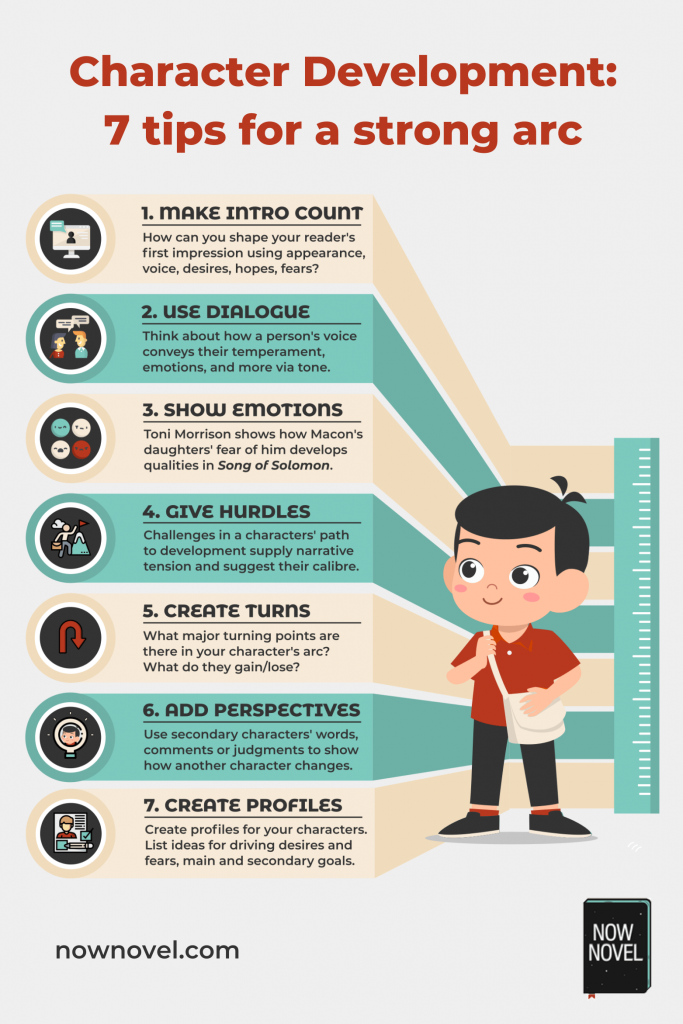Knowing how to develop a character so your reader invests in them and believes their journey is key to writing great character-driven stories. Try these 7 simple steps to begin creating affecting, intriguing character arcs:
Developing characters in 7 steps:
- What is character development?
1. Make the first introduction count
2. Develop personality using dialogue
3. Create driving fears
4. Give characters hurdles
5. Create turning points
6. Add perspective via secondary characters
7. Write full character profiles
What is character development?
Character development means the process of change a character undergoes in the course of a story.
‘Zero to hero’ (or hero to zero, in the case of a tragedy like King Lear) is a type of character arc that summarizes what significant changes happen in the course of a character’s journey.
Writing good character development means creating a vivid sense of who your character is at the start of the story, and colouring in details such as background, hopes, dreams, fears, constructive and destructive choices and more.
The end result? A believable character arc.
Make the first introduction count
‘Don’t judge a book by its cover.’ How many times have you heard that? Yet first impressions are often deeply revealing (if we’re alert to what they suggest).
Start developing each character from their first introduction. Ask yourself:
- What does this character’s appearance suggest about their personality?
- What’s distinctive about them (how would you identify them in a police line-up?)
- What are their strengths, flaws, hopes and fears? What details of speech, movement or action could suggest these qualities?
Developing character introductions: An example
Here, for example, Toni Morrison introduces the character Pilate in her novel Song of Solomon. The backstory: Milkman is meeting Pilate, his aunt, for the first time. His father, disapproving of his sister, forbids his children spending time with her.
They found her on the front steps sitting wide-legged in a long-sleeved, long-skirted black dress. Her hair was wrapped in black too, and from a distance, all they could really see beneath her face was the bright orange she was peeling. She was all angles, he remembered later, knees, mostly, and elbows. One foot pointed east and one pointed west.
Toni Morrison, Song of Solomon (1977), p. 36.
This beautiful description gives a clear impression. Pilate’s ‘wide-legged’ sitting stance suggests a free spirit. There’s a witchy quality to her long, black garments. The idea of her feet pointing opposite directions, east and west, suggests contrariness; opposition.
Morrison continues to reveal character as she shows Milkman’s favourable impression, in contrast to his father’s own:
As they came closer and saw the brass box dangling from her ear, Milkman knew that what with the earring, the orange, and the angled black cloth, nothing – not the wisdom of his father nor the caution of the world – could keep him from her.
Morrison, p. 36.
In one page, Morrison gives us both a vivid visual sense of Pilate and how a main character feels about her on first meeting.
This establishes emotional connection, while creating room for further character development.
Develop personality using dialogue
Dialogue is useful for developing characters.
Unsure how to develop a character? Give them something characterful to say.
How people speak is full of giveaway signs of their personalities and temperaments. Take, for example, how Morrison develops Pilate’s character further. Milkman’s friend, Guitar, is the first to speak up:
“Hi.”
The woman looked up. First at Guitar and then at Milkman.
“What kind of word is that?” Her voice was light but gravel-sprinkled. Milkman kept on staring at her fingers, manipulating the orange. Guitar grinned and shrugged. “It means hello.”
“Then say what you mean.”
“Okay. Hello.”
“That’s better. What you want?”Morrison, p. 36.
This dialogue immediately develops Pilate further. Morrison shows us her tough, uncompromising nature. Her words are direct. She thinks before she speaks, and she gets straight to the point. Her clipped, brusque tone suggests wariness. Her immediate leap to ‘What you want?’ conveys a hint of cynical mistrust.
To develop character in their first moments of dialogue, ask:
- What does this person’s voice convey about their personality? (‘gravel-sprinkled’ suggests a hard-edged steeliness, for example)
- How do they respond to things like questions, teasing? Are they defensive? Open? Downright rude?
- How do all the details of speech combine to develop the character?

Create driving fears and desires
A big part of learning how to develop a character is understanding characters’ drives. What propels them forward? What holds them back? [Get our guide How to Write Real Characters for practical character development exercises and examples.]
Formative fears and desires are the aversions and wants – the backstories – that shape us.
In Song of Solomon, Morrison establishes early that the daughters of Macon Dead and Ruth (Milkman’s sisters) live in fear of their father. The author narrates:
The disappointment he felt in his daughters sifted down on them like ash, dulling their buttery complexions and choking the lilt out of what should have been girlish voices. Under the frozen heat of his glance they tripped over doorsills and dropped the salt cellar into the yolks of their poached eggs.
Morrison, pp. 10-11.
This description shows how fear of their father is an animating, driving factor in the girls’ lives. It sows the seeds of further character development. In fact, the dynamic between the girls and their father also supplies tension and desires, as Morrison continues:
The way he mangled their grace, wit, and self-esteem was the single excitement of their days. Without the tension and drama he ignited, they might not have known what to do with themselves. In his absence his daughters bent their necks over blood-red squares of velvet and waited eagerly for any hint of him…
Morrison, p. 11.
Morrison’s description is a masterclass in how to develop character. Again, in a single page, she shows how the girls’ relationship with their father is both a source of fear and tension and a driving force in their motivations and behaviour. This builds our expectations for further developments and complications within the family unit.
Give characters hurdles
In show-jumping, the moment of tension is when we wonder if the horse will clear the hurdle. Giving your characters hurdles to clear in their story paths creates similar excitement and tension. Hurdles or obstacles are also great for developing characters.
For example, if you wanted to decide how to develop a character in a romance through the hurdles they face, you could:
- Create distance: The love interest is suddenly taken far away
- Add hurdle-forming flaws: One character (or both) brings baggage to their interactions, threatening the harmony and stability of their relationship
- Add meddling third parties: For example, in Romeo and Juliet, the fact the ill-fated lovers’ families are feuding complicates and threatens their connection
Hurdles are fascinating testing grounds for characters. Develop yours by showing how they handle tensions and the impossible leaps they might not make. What are their successes? What are their failures? And what do they learn throughout?
Create turning points
Literature is full of incidents characters can’t come back from, points of no return. Sometimes, these signal a clear downward spiral or path. For example, if a character:
- Commits a serious crime such as murder
- Makes a terrible financial decision
- Betrays someone close to them too deep for forgiveness
Other times, developmental turning points are clearly for the better. E.g. a character may:
- Overcome addiction
- Find a budding, fulfilling romantic connection
- Discover a sudden windfall (e.g. Pip’s inheritance in Charles Dickens’ Great Expectations
Turning points such as these introduce change. Showing how your characters respond to these changes is what character development is all about. What does the murderer do next? How will the gambler get out of his debts? How will the philanderer make amends (or be betrayed themselves in turn?).
To make your turning points more unpredictable and give them narrative suspense, bring in moments of opposite ‘pull’. For example, in an overarching turn for the worse, an occasional optimistic plot point will avoid the story becoming one-note.
The same goes for turning points for the better. What could bring everything toppling back down again? Let your character’s arc flirt with this possibility.
Add perspective via secondary characters
We saw with the examples from Song of Solomon above how Toni Morrison takes a nephew’s experience of his aunt and contrasts this with his father’s more negative viewpoint. In a multi-character novel, create complex development by showing the same character from multiple others’ viewpoints.
One of the great writers regarding this type of character development is Virginia Woolf. Woolf uses a type of third person POV technique we call ‘stream of consciousness’ to switch between multiple characters’ points of view. She does this even in a single scene, showing how, for example, characters seated around a dinner table see each other.
Secondary characters can develop sides of your main characters you haven’t yet shown the reader.
For example, a protagonist who seems tough as nails may become vulnerable when they meet someone who reminds them of a lost family member, lover or friend. Developments such as these reveal your characters’ layers. They make them more complex and fully human.

Write full character profiles
Learning how to develop a character is ultimately a process of writing.
Practice character writing exercises and creating character profiles.
A process of taking your characters through experiences and showing the changes that result. Ray Bradbury wrote that plot is nothing more than the footprints characters leave in the snow on their way to incredible destinations.
You do have the power, as a writer, to plan where and how these footprints will fall. What the backstory leading to your characters’ trek through the snow is.
Creating detailed character profiles is a useful way to broaden your own understanding of your character and their development. You don’t have to share every detail you brainstorm in the course of your story. Some details may simply be for your own benefit. They’ll remind you of the ‘behind the scenes’ details and situations that shape and drive your character.
Use Now Novel’s step-by-step character profile creator to brainstorm and finesse characters and their development.


5 replies on “How to develop a character: 7 simple steps”
This is in-depth. Thank you.
Hi Simisola, thank you for reading! We’re glad to help 🙂
superb
Thank you, Ibrahim. Happy New Year!
Good and Different approach.